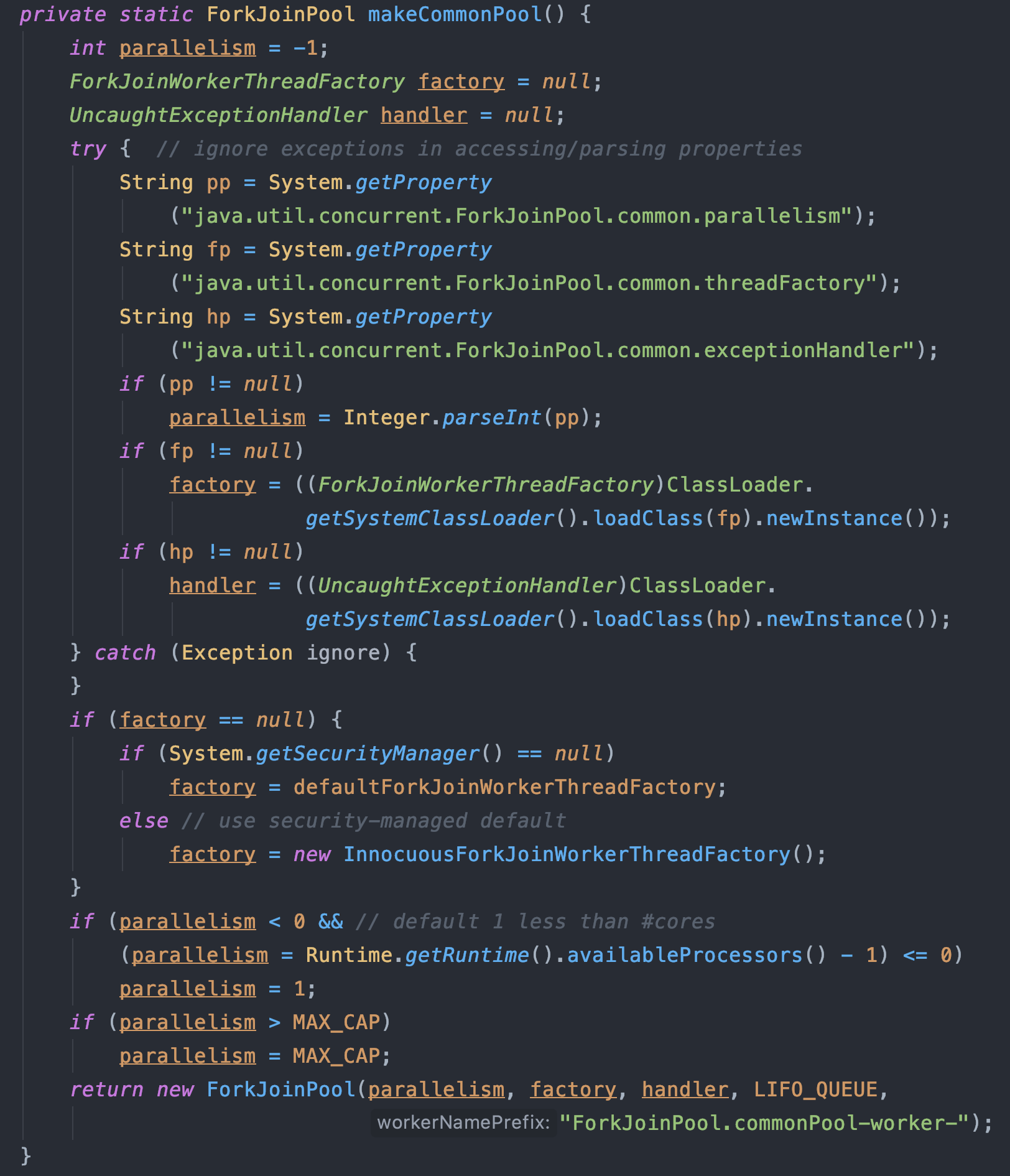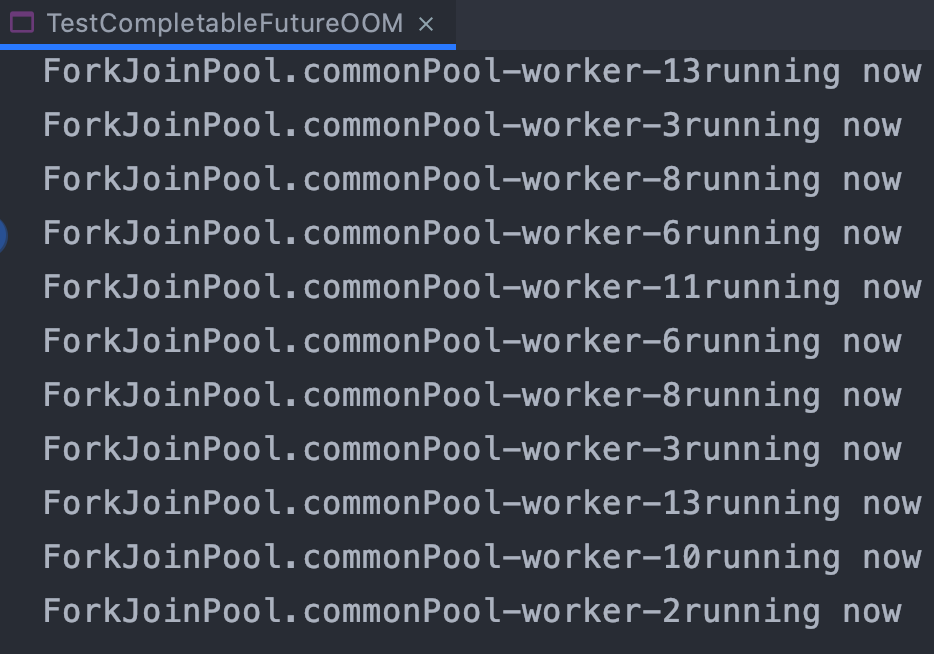CompletableFuture
Why not Future
首先,我们使用异步的场景最终都是通过传递Runnable或Callable对象。当我们传递Callable时有时会期望获取它的返回值,以用于我们接下来操作的执行。在以前,我们都是通过Future来管理我们的task,使用get()方法等待其返回结果,如下:
public static void main(String[] args) throws ExecutionException, InterruptedException {
ExecutorService executorService = Executors.newSingleThreadExecutor();
Future<String> future = executorService.submit(() -> {
Thread.sleep(2000);
return "async method";
});
Thread.sleep(1000);
System.out.println("main thread");
System.out.println(future.get());
}
当使用get()获取返回结果时,我们总是在主线程中阻塞地等待其返回,或者我们通过一个忙循环不断地调用isDone(),这样的使用并不优雅,甚至使用get()一定程度上失去了异步编程的意义。这种情况下,CompletableFuture应运而生。
CompletableFuture简介
通过查看其Java Docs,我们得知:
CompletableFuture可以明确得知其任务执行状态,并可以设置完成时回调的增强版Future- 除了直接操作状态、结果之外,
CompletableFuture还实现了CompletionStage接口的方法thenApply:为线程执行结束提供了设置回调的入口- 所有没有显示
Executor参数的异步方法都是使用ForkJoinPool.commonPool()执行的。为了简化监视、调试和跟踪,所有生成的异步任务都是CompletableFuture.AsynchronousCompletetionTask(一个空的接口)- 一个很容易产生的疑惑是,虽然
thenApply提供了我们自定义线程池的入口,但是同样也支持不传入线程池参数的方法,这里使用的是ForkJoinPool,那会不会由于大量线程产生导致OOM呢? - 查看源码得知,其使用的是
ForkJoinPool.commonPool(),该线程池会基于系统参数设定其大小,而实际运行也可以发现,涌入大量线程时,实际也只有十几个ForkJoinPool线程在运行: 

- 一个很容易产生的疑惑是,虽然
- 所有的
CompletionStage的方法都是未标记@override的,这样即使子类重写也不会产生影响 - 此外,
CompletableFuture同样是Future的实现,这意味着其也支持Future的操作,其中cancel与completeexceptionally有相同效果isCompletedExceptionally可以确定方法是否通过任何形式结束- 如果使用
CompletionException异常完成,则get()和get(long, TimeUnit)方法会抛出ExecutionException
CompletableFuture API
- 创建任务
// 创建带有返回值的任务(Callable)
public static <U> CompletableFuture<U> supplyAsync(Supplier<U> supplier)
public static <U> CompletableFuture<U> supplyAsync(Supplier<U> supplier, Executor executor)
// 创建无返回值的任务(Runnable)
public static CompletableFuture<Void> runAsync(Runnable runnable)
public static CompletableFuture<Void> runAsync(Runnable runnable, Executor executor)
- 使用示范
CompletableFuture.supplyAsync(() -> "Hello World");
CompletableFuture.runAsync(() -> System.out.println("Hello World"));
- 获取结果(终止操作)
// 阻塞等待返回结果
T get();
// 在指定超时时间内阻塞等待返回结果
T get(long timeout, TimeUnit unit);
// 正常情况下与get无差别,取消时会抛出CancellationException,异常时会抛出CompletionException
T join();
// 立马获取返回结果,如果获取不到则返回valueIfAbsent
T getNow(T valueIfAbsent);
- 处理结果
// 处理执行结果或异常(result, throwable) -> {}
public CompletableFuture<T> whenComplete(BiConsumer<? super T,? super Throwable> action)
// 上述场景的异步化处理
public CompletableFuture<T> whenCompleteAsync(BiConsumer<? super T,? super Throwable> action)
public CompletableFuture<T> whenCompleteAsync(BiConsumer<? super T,? super Throwable> action, Executor executor)
// 当原始CompletableFuture抛出异常,返回一个新的CompletableFuture,将该异常作为参数传递
public CompletableFuture<T> exceptionally(Function<Throwable,? extends T> fn)
- 使用示范
CompletableFuture.supplyAsync(() -> Thread.currentThread().getName() + "running now")
.whenComplete((result, throwable) -> System.out.println(result));
CompletableFuture.supplyAsync(() -> Thread.currentThread().getName() + "running now")
.whenCompleteAsync((result, throwable) -> System.out.println(result));
CompletableFuture.supplyAsync(() -> Thread.currentThread().getName() + "running now")
.exceptionally(throwable -> System.out.println(throwable.getCause());
- 设置回调
// 线程执行完毕后设置回调
public <U> CompletionStage<U> thenApply(Function<? super T,? extends U> fn);
// 线程执行完毕后设置异步回调
public <U> CompletionStage<U> thenApplyAsync (Function<? super T,? extends U> fn);
// 线程执行完毕后设置异步回调,并使用指定线程池执行
public <U> CompletionStage<U> thenApplyAsync (Function<? super T,? extends U> fn, Executor executor);
- 使用示范
CompletableFuture.supplyAsync(() -> 128)
.thenApply(i -> i/2)
.thenApplyAsync(i -> i/2)
.whenComplete((result, throwable) -> System.out.println(result));
- 纯消费
// 只处理结果,只有输入,没有输出
public CompletionStage<Void> thenAccept(Consumer<? super T> action);
// 异步执行
public CompletionStage<Void> thenAcceptAsync(Consumer<? super T> action);
// 指定线程池异步执行
public CompletionStage<Void> thenAcceptAsync(Consumer<? super T> action, Executor executor);
// 多个CompletableFuture结果聚合消费
public <U> CompletionStage<Void> thenAcceptBoth(CompletionStage<? extends U> other, BiConsumer<? super T, ? super U> action);
// 多个CompletableFuture结果异步聚合消费
public <U> CompletionStage<Void> thenAcceptBothAsync(CompletionStage<? extends U> other, BiConsumer<? super T, ? super U> action);
// 多个CompletableFuture结果异步聚合消费,并使用指定线程池执行
public <U> CompletionStage<Void> thenAcceptBothAsync(CompletionStage<? extends U> other, BiConsumer<? super T, ? super U> action, Executor executor);
// 或者使用无返回值的Runnable
public CompletionStage<Void> runAfterBoth(CompletionStage<?> other, Runnable action);
public CompletionStage<Void> runAfterBothAsync(CompletionStage<?> other, Runnable action);
public CompletionStage<Void> runAfterBothAsync(CompletionStage<?> other, Runnable action, Executor executor);
// 或者单纯执行一个Runnable
public CompletionStage<Void> thenRun(Runnable action);
public CompletionStage<Void> thenRunAsync(Runnable action);
public CompletionStage<Void> thenRunAsync(Runnable action, Executor executor);
- 使用示范
// 创建一个CompletableFuture
CompletableFuture.supplyAsync(() -> 128)
// 执行第一个CompletableFuture
.thenApplyAsync(i -> i/2)
// 传入第二个CompletableFuture, 并对两者结果进行计算
.thenAcceptBothAsync(CompletableFuture.supplyAsync(() -> 1000)
.thenApplyAsync(i -> i/2),
(i1, i2) -> System.out.println(i1 + i2));
- 组合
// 用于传入一个CompletableFuture的执行结果,并作为参数传递给另一个定义的CompletableFuture
// 与thenAcceptBoth相比,其使用BiConsumer接收,无返回值,而thenCompose使用Function接收,有返回值
public <U> CompletionStage<U> thenCompose(Function<? super T, ? extends CompletionStage<U>> fn);
public <U> CompletionStage<U> thenComposeAsync(Function<? super T, ? extends CompletionStage<U>> fn);
public <U> CompletionStage<U> thenComposeAsync(Function<? super T, ? extends CompletionStage<U>> fn, Executor executor);
- 使用示范
CompletableFuture.supplyAsync(() -> 4299)
.thenCompose(result -> CompletableFuture.supplyAsync(() -> "Now you can get iPhone11 with price ¥" + result))
.whenComplete((result, throwable) -> System.out.println(result));
- 任一结束则执行
// 上述compose或both都是等所有CompletableFuture执行完才进行消费,而either是任意ComplatebleFuture执行完则开始消费
// 下述API的区别与上述同理,Function存在返回值,Consumer无返回值
public <U> CompletionStage<U> applyToEither(CompletionStage<? extends T> other, Function<? super T, U> fn);
public CompletionStage<Void> acceptEither(CompletionStage<? extends T> other, Consumer<? super T> action);
- 使用示范
CompletableFuture.supplyAsync(() -> {
try {
Thread.sleep(2000);
} catch (InterruptedException e) {
e.printStackTrace();
}
return "CompletableFuture 1#";
})
// .acceptEither(CompletableFuture.supplyAsync(() -> "CompletableFuture 2#"), System.out::println);
.applyToEither(CompletableFuture.supplyAsync(() -> "CompletableFuture 2#"), input -> input)
.whenComplete((result, throwable) -> System.out.println(result));
- 组合多个
CompletableFuture的辅助方法
// 所有CompletableFuture执行完成开始计算
public static CompletableFuture<Void> allOf(CompletableFuture<?>... cfs) {}
// 任一CompletableFuture执行完成开始计算
public static CompletableFuture<Object> anyOf(CompletableFuture<?>... cfs) {}
- 使用示范
// 不存在返回值,但是会等待所有CompletableFuture执行结束
CompletableFuture<Void> allFutures = CompletableFuture.allOf(
CompletableFuture.supplyAsync(() -> 1000),
CompletableFuture.supplyAsync(() -> 2000),
CompletableFuture.supplyAsync(() -> 3000)
);
allFutures.get();
// 存在返回值,只要有任一CompletableFuture执行结束即进行计算
CompletableFuture.anyOf(
CompletableFuture.supplyAsync(() -> {
try {
Thread.sleep(1000);
} catch (InterruptedException e) {
e.printStackTrace();
}
return 100;
}),
CompletableFuture.supplyAsync(() -> 200)
)
.whenComplete((r, t) -> System.out.println(r));
- 一些额外的技巧
// 将结果组合为集合形式
public static <T> CompletableFuture<List<T>> sequence(List<CompletableFuture<T>> futures) {
CompletableFuture<Void> allDoneFuture = CompletableFuture.allOf(futures.toArray(new CompletableFuture[futures.size()]));
return allDoneFuture.thenApply(v -> futures.stream().map(CompletableFuture::join).collect(Collectors.<T>toList()));
}
public static <T> CompletableFuture<Stream<T>> sequence(Stream<CompletableFuture<T>> futures) {
List<CompletableFuture<T>> futureList = futures.filter(f -> f != null).collect(Collectors.toList());
return sequence(futureList);
}
// Future转CompletableFuture
public static <T> CompletableFuture<T> toCompletable(Future<T> future, Executor executor) {
return CompletableFuture.supplyAsync(() -> {
try {
return future.get();
} catch (InterruptedException | ExecutionException e) {
throw new RuntimeException(e);
}
}, executor);
}
闲话
最近其实在看Reactor的一些编程模型,发现这跟CompletableFuture存在一些类似之处,都是异步的容器,可以添加对结果的响应,简化我们的编码,但是它们还是存在一些不同,所以我对CompletableFuture进行了一些学习,总结如下:
- Reactor是事件的容器,无论0->n的
Flux或是0->1的Mono,传递的都是事件;而CompletableFuture传递的是结果 - 正因为Reactor传递的是事件,所以在Reactor创建的时候事件不会执行,直到产生订阅;而
CompletableFuture在创建时已经提交了异步任务执行,所以容器承载的是异步结果(当然也可能还没执行完) - 因为Reactor发布-订阅机制,所以允许存在多个订阅方(消费多次);
CompletableFuture的结果只能被一次消费(或是传递给新的CompletableFuture,如前面提到的exceptionally)